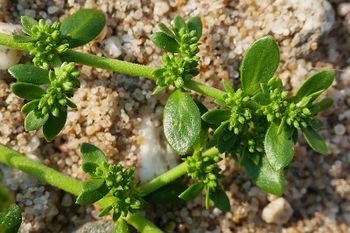Smooth Rupturewort
Other Names : Herniaria glabra, Kahles Bruchkraut, Kaal breukkruid, Turquette
a medicinal herb that grows wild across Europe, North Africa and West Asia. The entire aerial parts of the plant are used to make herbal medicines. The flowering plants are harvested in summer then quickly dried in the shade. The active ingredients found in the herb can break down quickly if the plant is stored too long. Because of this, the fresh herb may be the best way to go. If it is not possible to find the fresh variety, then it is recommended to use the herb before it has been stored for a long time.
Special Precautions of Smooth Rupturewort
- When it comes to herbal treatments, the regulations are not as as strict as those for other drugs. At present, there is not enough information about the safety of rupturewort to determine whether it is safe and more studies are needed.
- Make sure that you speak to your doctor before using rupturwort especially if you are pregnant or suffer from any pre-existing illness. Rupturewort may also interact with other medications so it is important to consult your doctor before using the herb.
- Pregnant women should not use rupturewort because there is insufficient evidence regarding its safety. The same applies to women who are breastfeeding.
- Rupturewort may have diuretic effects meaning it helps flush fluids out of the system like a pharmaceutical water pill. Because of this using rupturewort may affect the body’s ability to rid itself of lithium. If you are using lithium, it is important to speak with your doctor before using rupturewort.
Health Benefits and Uses of Smooth Rupturewort
The name Rupturewort as well as its scientific name are derived from its traditional use in treating ruptured or herniated skin as opposed to internal hernias. The herb is still used in a poultice and applied to the skin to help heal minor wounds and ulcers. The herb contains up to 10% saponins as active ingredients, as well as flavonoids and coumarins. The dried aerial parts are used.
- In laboratory rats, a reduction in excessive blood pressure and promoting the filtration rate of their kidneys has been observed
- A tea is used as a folk medicine as a diuretic for flushing urinary stones, kidney semolina and convulsions.
- A weakly spasmolytic effect of the drug is considered accepted, the effectiveness in the field of public health applications however is not yet sufficiently demonstrated.
- Urinary Tract Infections : Rupturewort has been used for centuries for medicine and the first mention of its use dates back to the early 1500s when it was sued as a natural diuretic to treat urinary tract infections and cystitis. Together with Cowberry (Vaccinium vitis-idaea) , it has the strongest antimicrobial activity against uropathogenic Escherichia coli bacteria in a number of tested substances and is therefore effective in bladder and ureteral disorders. Unfortunately, no scientific studies have been done to confirm its efficacy with regard to urinary tract disorders.
- wound Healing : Ruprurewort has also been used traditionally to help treat minor wounds and ulcers. Its common name as well as its scientific name – ‘Herniaria’ stem from its purported ability to treat herniated or ruptured skin. Because it has astringent properties, the herb is applied topically in the form of a poultice to help speed up the healing of minor wounds, ulcers and sores.
- Arthritis and Gout : Rupturewort has also been used to help treat joint conditions like rheumatism and arthritis. Unfortunately, there is no evidence to confirm its efficacy and we are reliant on anecdotal evidence and traditional use. It is also sometimes used to treat gout possibly because of its purported diuretic ability. Because of its diuretic actions, rupturewort may help flush uric acid and other toxins from the system. It is the build-up of uric acid which cause painful episodes of gout.
